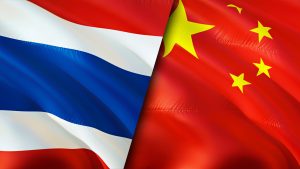Earlier today, the Bangkok Post carried a short report about a meeting between Thai Transport Minister Saksayam Chidchob and Han Zhiqiang, the recently appointed Chinese ambassador to Thailand. As per the report, the meeting involved discussions on possible Chinese support for a number of transport infrastructure projects, including the MR Map, a Thai connectivity initiative, and the Southern Land Bridge project, which will enable cargo transport between the Gulf of Thailand and the Andaman Sea.
But Saksayam said that he had also discussed with the Chinese ambassador progress in the long-delayed Thai-Chinese high-speed railway project. In particular, Saksayam related to the Chinese envoy that Prime Minister Prayut Chan-o-cha was keen to accelerate the construction of the rail project in order for it to be connected as soon as possible with the Laos-China Railway, which was inaugurated with much fandare on December 3 after six years of construction.
The first phase of the Thai-Chinese railway project runs from Bangkok to Nakhon Ratchasima, is currently under construction and is expected to begin operations in 2026. Transport Minister Saksayam added that the design of the railway’s second phase, which runs from Nakhon Ratchasima to Nong Khai, is now complete, and that talks are underway between Thailand, Laos, and China to complete the development of the route.
As some observers have noted, this news will no doubt be sweet music to the ears of the leadership in neighboring Laos, which has taken on more than $1.5 billion in loans from China’s Eximbank to help finance its section of the railway.
The new railway line, which runs from Kunming, the capital of China’s Yunnan province, to the Lao capital Vientiane, is the first link in a pan-Asian railway linking Beijing with Singapore, a long-envisioned scheme that has since been absorbed into China’s headline Belt and Road Initiative. The next link in the chain will run from Nong Khai, which sits across the Mekong River from Vientiane, to Bangkok.
While the Lao rail project is undeniably impressive, bearing bullet trains at a speed of 160 kilometers per hour through the one nearly impassable terrain of northern Laos, some observers have raised doubts about the profitability of the Chinese-built rail project. Due to COVID-19, the government of Laos is facing mounting debt pressures, and the long-term profitability of the railway could depend on whether it is eventually extended into Thailand.
But there was no certainty about this. Since its inception in 2014, the Sino-Thai rail project has been beset by delays, as Thailand’s bureaucracy has pulled it up over questions of design, financing, and technical assistance. And while the line between Bangkok and Nakhon Ratchasima has inched forward, there was until relatively recently no definitive confirmation that it would be extended all the way to Nong Khai.
In September, Thailand’s Department of Rail Transport unveiled a plan to develop a trade depot in Nong Khai to handle the increased cargo shipments from China coming down the new railway line, and to prepare for the eventual rail connection with Laos. According to a report in the Bangkok Post, the first high-speed train between Bangkok and Nong Khai is currently expected in 2028.
Given the delays that have plagued the project so far, however, it would be reasonable to expect that this timeline will extend itself further.

































